Themed collection Top articles from NCNST

Circularly polarized luminescent porous crystalline nanomaterials
An overview of generation, regulation and amplification of circularly polarized luminescence (CPL) in porous crystalline nanomaterials by direct synthesis, chirality induction or adaption, and symmetry breaking pathways.
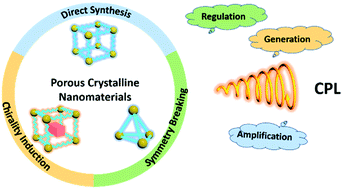
Nanoscale, 2022,14, 1123-1135
https://doi.org/10.1039/D1NR07069J
Gold nanoparticles for the colorimetric and fluorescent detection of ions and small organic molecules
We review recent advances in the development of AuNP-based colorimetric and fluorescent assays for ions and small organic molecules.
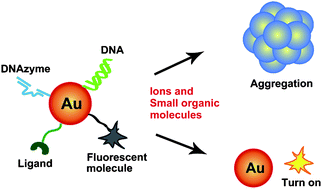
Nanoscale, 2011,3, 1421-1433
https://doi.org/10.1039/C0NR00887G
The material–microorganism interface in microbial hybrid electrocatalysis systems
This review presents a comprehensive summary of the material–microorganism interface in microbial hybrid electrocatalysis systems.

Nanoscale, 2023,15, 6009-6024
https://doi.org/10.1039/D3NR00742A
Advanced nitric oxide donors: chemical structure of NO drugs, NO nanomedicines and biomedical applications
Nitric oxide (NO), as an endogenous diatomic molecule, plays a key regulatory role in many physiological and pathological processes.
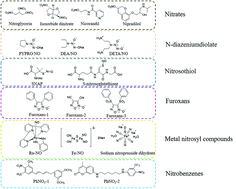
Nanoscale, 2021,13, 444-459
https://doi.org/10.1039/D0NR07484E
Recent advances in transition-metal dichalcogenide based nanomaterials for water splitting
We present an overview of the state-of-the-art research progresses in layered and pyrite-phase structured TMDs for electrocatalytic and photocatalytic water splitting.

Nanoscale, 2015,7, 19764-19788
https://doi.org/10.1039/C5NR06718A
Visible light driven type II heterostructures and their enhanced photocatalysis properties: a review
We trace the application of type II heterostructured semiconductors in the area of environmental remediation and water splitting, summarize major fabrication methods, describe some of the progress and resulting achievements.
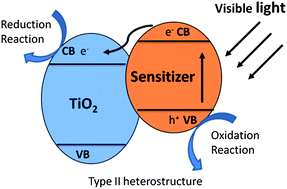
Nanoscale, 2013,5, 8326-8339
https://doi.org/10.1039/C3NR01577G
Nano–bio effects: interaction of nanomaterials with cells
The cellular uptake, intracellular trafficking and toxic response while nanomaterials attach to cells are discussed. Nanomaterials may disrupt lysosome membrane and translocated into mitochondrion or nucleus, in which induce reactive oxygen species (ROS) or genotoxic effects.

Nanoscale, 2013,5, 3547-3569
https://doi.org/10.1039/C3NR34276J
Biomedical nanomaterials for imaging-guided cancer therapy
This review might provide new impetus to understand nanotechnology and nanomaterials employed for imaging-guided cancer therapy.

Nanoscale, 2012,4, 6135-6149
https://doi.org/10.1039/C2NR31715J
Carbonic anhydrase IX-targeted nanovesicles potentiated ferroptosis by remodeling the intracellular environment for synergetic cancer therapy
This work demonstrated a nanovesicle-potentiated ferroptosis by remodeling the tumor intracellular environment, providing a promising paradigm for designing nanomedicines to heighten ferroptosis-based synergetic therapeutics.

Nanoscale Horiz., 2023,8, 783-793
https://doi.org/10.1039/D2NH00494A
Single atomic Fe–N4 active sites and neighboring graphitic nitrogen for efficient and stable electrochemical CO2 reduction
Single atomic Fe–Nx moieties have shown great performance in CO2-to-CO conversion.
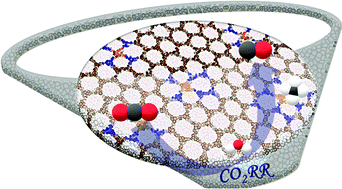
Nanoscale Horiz., 2022,7, 916-923
https://doi.org/10.1039/D2NH00143H
Inhibition of cardiomyocyte apoptosis post-acute myocardial infarction through the efficient delivery of microRNA-24 by silica nanoparticles
Silica nanoparticles, being easily surface-functionalized and suitable for carrying miRNA-24 which downregulated in cardiomyocytes after acute myocardial infarction.
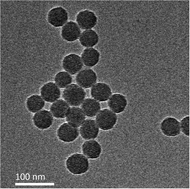
Nanoscale Adv., 2021,3, 6379-6385
https://doi.org/10.1039/D1NA00568E
Small molecule-decorated gold nanoparticles for preparing antibiofilm fabrics
By using ultrasound-assisted coating technology, we modified fabrics with N_Au NPs to fabricate antibiofilm fabrics.

Nanoscale Adv., 2020,2, 2293-2302
https://doi.org/10.1039/D0NA00179A
Photoluminescence enhancement of MoS2/CdSe quantum rod heterostructures induced by energy transfer and exciton–exciton annihilation suppression
The exciton dynamics of the acceptor are revealed and enhanced photoluminescence of the heterostructure is achieved by energy transfer and exciton–exciton annihilation suppression.
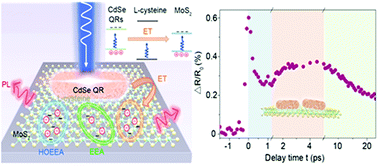
Nanoscale Horiz., 2020,5, 971-977
https://doi.org/10.1039/C9NH00802K
Fe3O4–Pd Janus nanoparticles with amplified dual-mode hyperthermia and enhanced ROS generation for breast cancer treatment
Biocompatible Fe3O4-Pd Janus nanoparticles were designed to achieve significantly high magnetic-photo heating efficiency accompanied by enhanced ROS generation for efficient cancer therapy.
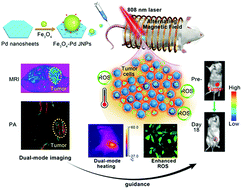
Nanoscale Horiz., 2019,4, 1450-1459
https://doi.org/10.1039/C9NH00233B
Unveiling lasing mechanism in CsPbBr3 microsphere cavities
The mechanism of single-mode lasing in CsPbBr3 microsphere shifts from exciton–exciton scattering to exciton–phonon scattering with the increase in temperature from 77 to 300 K, and two different phonon modes were involved in the exciton–phonon scattering process.

Nanoscale, 2019,11, 3145-3153
https://doi.org/10.1039/C8NR09634A
Optically active quantum dots with induced circularly polarized luminescence in amphiphilic peptide dendron hydrogel
Semiconductor quantum dots showing controlled circularly polarized luminescence were achieved through co-assembling with chiral peptide dendron gelator in water.
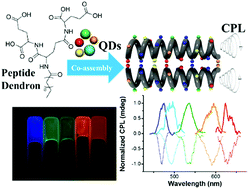
Nanoscale Adv., 2019,1, 508-512
https://doi.org/10.1039/C8NA00216A
High-temperature driven inter-valley carrier transfer and significant fluorescence enhancement in multilayer WS2
A high-temperature driven carrier transfer process of multilayer WS2 is proposed and demonstrated for significant fluorescence emission enhancement.

Nanoscale Horiz., 2018,3, 598-605
https://doi.org/10.1039/C8NH00123E
A lead-free two-dimensional perovskite for a high-performance flexible photoconductor and a light-stimulated synaptic device
A high-performance flexible photoconductor based on a lead-free perovskite was made and it can be used as a light-stimulated synaptic device.
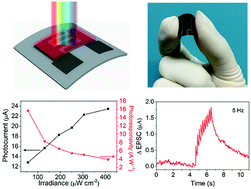
Nanoscale, 2018,10, 6837-6843
https://doi.org/10.1039/C8NR00914G
In situ formation of peptidic nanofibers can fundamentally optimize the quality of immune responses against HIV vaccine
Peptidic nanofibers can provide convenience for administration, and facilitate the induction of multiple crucial immunities against HIV DNA vaccine, including polyfunctional T cell response, broad IgG subclasses response, and V1/V2 loop-specific antibody response.
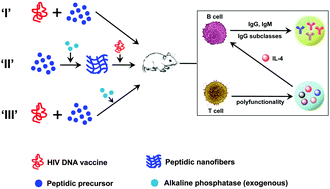
Nanoscale Horiz., 2016,1, 135-143
https://doi.org/10.1039/C5NH00064E
An 80.11% FF record achieved for perovskite solar cells by using the NH4Cl additive
CH3NH3PbI3/PC61BM solar cells fabricated using the NH4Cl additive gave a decent PCE of 9.93% and a very outstanding FF of 80.11%.

Nanoscale, 2014,6, 9935-9938
https://doi.org/10.1039/C4NR02425G
Flower-like TiO2 nanostructures with exposed {001} facets: Facile synthesis and enhanced photocatalysis
Flower-like TiO2 nanostructures with exposed {001} facets were synthesized from Ti powders, and exhibited high photocatalytic activity.
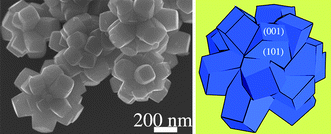
Nanoscale, 2010,2, 1115-1117
https://doi.org/10.1039/C0NR00050G
The self-assembly of a pair of low-symmetry tetracarboxylic acid molecules and their co-assembly with bridging molecules at the liquid–solid interface
In this work, the self-assembly behavior of a pair of low-symmetry carboxylic acid molecules (H4OBDB and H4ADDI) and their co-assembly behavior with trimesic acid (TMA) as a bridging molecule were studied using a scanning tunneling microscope (STM).

Nanoscale, 2023,15, 4353-4360
https://doi.org/10.1039/D2NR06740D
Versatile fabrication of metal sulfide supraparticles by an in situ decomposition–assembly strategy
Herein, an in situ decomposition–assembly strategy for the versatile fabrication of metal sulfide SPs is developed. In addition to homogeneous Cu2S, CdS, and ZnS products, the proposed system can even be extended to fabricate hybrid Cu2S/Fe2O3 SPs.
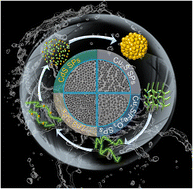
Nanoscale Adv., 2023,5, 1190-1198
https://doi.org/10.1039/D2NA00747A
Insight into atomically dispersed porous M–N–C single-site catalysts for electrochemical CO2 reduction
Various 3d transition metal single-atom catalysts supported on N-doped carbon black have been synthesized as alternative low-cost catalysts for electrochemical CO2 reduction with superior activity and stability.
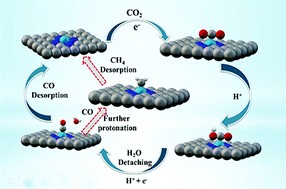
Nanoscale, 2020,12, 16617-16626
https://doi.org/10.1039/D0NR03044A
Buckled AgNW/MXene hybrid hierarchical sponges for high-performance electromagnetic interference shielding
The development of electromagnetic interference (EMI) shielding materials is moving forward towards being lightweight and showing high-performance.
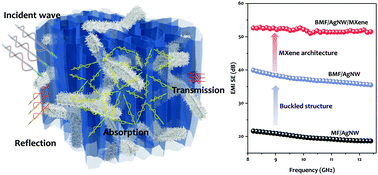
Nanoscale, 2019,11, 22804-22812
https://doi.org/10.1039/C9NR07988B
A carbon foam-supported high sulfur loading composite as a self-supported cathode for flexible lithium–sulfur batteries
This work reports the assembly of a carbon nanotube hybrid 3D flexible multifunctional film, which further adsorbs sulfur nanoparticles to form a flexible electrode. This electrode offers considerable potential for practical application in flexible Li–S batteries.
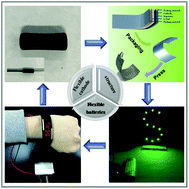
Nanoscale, 2018,10, 21790-21797
https://doi.org/10.1039/C8NR07964A
Supercapacitor electrode materials with hierarchically structured pores from carbonization of MWCNTs and ZIF-8 composites
The combination of highly N-doped porous carbon structures and a conductive skeleton greatly improved supercapacitance performance.
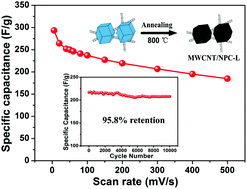
Nanoscale, 2017,9, 2178-2187
https://doi.org/10.1039/C6NR08987A
Pt74Ag26 nanoparticle-decorated ultrathin MoS2 nanosheets as novel peroxidase mimics for highly selective colorimetric detection of H2O2 and glucose
To extend the functionalities of two-dimensional graphene-like layered compounds as versatile materials, the modification of MoS2 nanosheets with metal nanoparticles is of great and widespread interest.
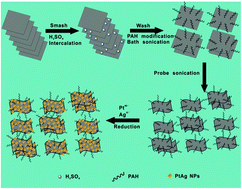
Nanoscale, 2016,8, 3685-3693
https://doi.org/10.1039/C5NR08038J
Broadly tunable graphene plasmons using an ion-gel top gate with low control voltage
The electrostatic tunability of graphene is vital in the field of active plasmons and would be beneficial in tunable infrared and terahertz optical element applications.
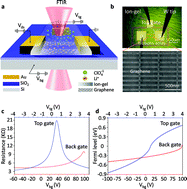
Nanoscale, 2015,7, 19493-19500
https://doi.org/10.1039/C5NR05175D
WS2 nanosheet as a new photosensitizer carrier for combined photodynamic and photothermal therapy of cancer cells
We have developed a facile strategy to fabricate WS2 nanosheets in a large scale that could not only efficiently load photosensitizers but also regulate their singlet-oxygen generation by NIR irradiation.

Nanoscale, 2014,6, 10394-10403
https://doi.org/10.1039/C4NR02453B
About this collection
In celebration of the 20th anniversary of the National Center for Nanoscience and Technology (NCNST) in China and to highlight the strong connection between Nanoscale Horizons, Nanoscale and Nanoscale Advances and the institute we wanted to showcase some of the most exceptional research and reviews that have been published in the journals over the years since their launch in partnership with NCNST.
The collection features some of the most cited articles from each year, some of the most popular articles and some of the most recent publications from NCNST in the nanoscale family of journals.